Non-Disclosure Agreements (NDAs) establish protections for confidential or proprietary information that must be shared. For years, corporate legal teams have used contract templates to expedite the process of drawing up NDAs. However, these generic documents may not provide comprehensive coverage for your specific needs—whether the NDA covers transactions involving employment, RFP bidding, vendors, investors, or a new partnership. Recent innovations in legal tech have enabled legal departments to leverage artificial intelligence (AI) to establish next-generation guidelines on how to write a Non-Disclosure Agreement.
.jpg?width=691&name=shutterstock_1341725984%20(1).jpg)
How To Write a Non-Disclosure Agreement: The Old Way
An unclear or incomplete NDA can expose a company to liability. In order to protect the party disclosing the confidential information and the party receiving that confidential information, the NDA must specify the parties who are privy to classified information while clearly establishing contract guidelines and expectations.
Typically, a legal professional writing the NDA will complete these steps:
- Step 1 - Describe the scope. Which information is considered confidential? Often, NDAs require a catch-all clause that ensures any information remains private that a “reasonable person” would assume should be confidential.
- Step 2 - Detail party obligations. What should the party that receives the information do to keep it confidential? How will they prevent third-parties from gaining access?
- Step 3 - Note potential exclusions. When can a party share confidential information? What information is already excluded from the definition of confidential information? Legal proceedings and the use of subcontractors represent situations where disclosure may be warranted.
- Step 4 - Set the term. Disclosing parties may want the agreement to last forever, but the receiving parties often desire a time limit. The interests of both parties must be considered when setting the term; there should be no ambiguity regarding the duration of confidentiality.
- Step 5 - Spell out consequences. Will a breach result in the termination of employment or of a business relationship? Can the aggrieved party seek an injunction or even damages in court?
While a template agreement may include sections that apply to each of the steps listed above, a template often cannot accommodate variance in terms. Likewise, a template-based agreement does not guarantee clear descriptions of protected information. To ensure all of the applicable nuances are covered, the review and negotiation process can stretch from days into weeks and months.
Non-Disclosure Agreements: The AI Way
Artificial intelligence (AI) has emerged as a disruptive game-changer in the way NDAs are written, reviewed, and negotiated—and the technology is surprisingly easy to use:
- Step 1: Email or upload contracts for review.
- Step 2: AI software combs the document, flags issues, provides attorney-quality text insertions, and aligns information to conform to your legal department’s system of controls aggregated in an AI Digital Playbook.
- Step 3: Accept changes in the fully marked-up document.
- Step 4: Send the contract to other relevant parties.
Until recently, advanced technology in legal tech was unable to “write” portions of these agreements. The latest tools developed by legal experts and AI linguistic researchers can now deliver fully-reviewed and negotiated contracts through an AI-powered contract negotiation platform.
AI Reviews and Revises Your NDAs in Minutes
When determining how to write, review, and negotiate a Non-Disclosure Agreement, AI-enabled tools rely on past contracts, exemplary examples, legal playbook standards, lawyer notes, natural language processing, and analytics data.
For legal and procurement teams that handle a high volume of NDAs, an AI platform can increase productivity by streamlining the contract negotiation process and allow your team to efficiently manage contract review and negotiation at scale.

.jpg?width=691&name=shutterstock_1341725984%20(1).jpg)